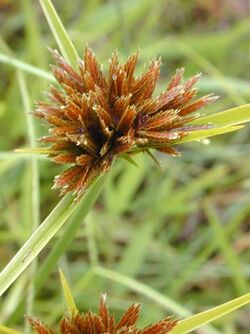Biology:Cyperaceae
| Cyperaceae | |
|---|---|

| |
| Cyperus polystachyos flower head | |
| Scientific classification | |
| Kingdom: | Plantae |
| Clade: | Tracheophytes |
| Clade: | Angiosperms |
| Clade: | Monocots |
| Clade: | Commelinids |
| Order: | Poales |
| Family: | Cyperaceae Juss.[1] |
| Genera | |
|
88, see text[2] | |
The Cyperaceae (/saɪpəˈreɪsiˌaɪ, -siːˌiː/) are a family of graminoid (grass-like), monocotyledonous flowering plants known as sedges. The family is large, with some 5,500 known species described in about 90 genera,[3][4] the largest being the "true sedges" genus Carex[5][6] with over 2,000 species.[7]
These species are widely distributed, with the centers of diversity for the group occurring in tropical Asia and tropical South America. While sedges may be found growing in almost all environments, many are associated with wetlands, or with poor soils. Ecological communities dominated by sedges are known as sedgelands or sedge meadows.
Some species superficially resemble the closely related rushes and the more distantly related grasses. Features distinguishing members of the sedge family from grasses or rushes are stems with triangular cross-sections (with occasional exceptions, a notable example being the tule which has a round cross-section) and leaves that are spirally arranged in three ranks. In comparison, grasses have alternate leaves, forming two ranks.[8][9][10]
Some well-known sedges include the water chestnut (Eleocharis dulcis) and the papyrus sedge (Cyperus papyrus), from which the writing material papyrus was made. This family also includes cotton-grass (Eriophorum), spike-rush (Eleocharis), sawgrass (Cladium), nutsedge or nutgrass (Cyperus rotundus, a common lawn weed), and white star sedge (Rhynchospora colorata).
Members of this family are characterised by the formation of dauciform roots; an alteration in root morphology that has been found to be analogous to cluster roots in Proteacea, which help uptake of nutrients such as phosphorus from poor soil.[11]
Genera
(As of 2020), 88 genera are accepted in Kew's Plants of the World Online:[2]
References
- ↑ Angiosperm Phylogeny Group (2009). "An update of the Angiosperm Phylogeny Group classification for the orders and families of flowering plants: APG III". Botanical Journal of the Linnean Society 161 (2): 105–121. doi:10.1111/j.1095-8339.2009.00996.x.
- ↑ 2.0 2.1 "Cyperaceae". Royal Botanic Gardens, Kew. https://powo.science.kew.org/taxon/urn:lsid:ipni.org:names:30000197-2.
- ↑ Christenhusz, M. J. M.; Byng, J. W. (2016). "The number of known plants species in the world and its annual increase". Phytotaxa (Magnolia Press) 261 (3): 201–217. doi:10.11646/phytotaxa.261.3.1. http://biotaxa.org/Phytotaxa/article/download/phytotaxa.261.3.1/20598. Retrieved 14 July 2016.
- ↑ R. Govaerts; D. A. Simpson; with J. Bruhl; T. Egorova; P. Goetghebeur; K. Wilson (2007). Word Checklist of Cyperaceae: Sedges. Royal Botanic Gardens, Kew. ISBN 978-1-84246-199-0.
- ↑ "Sedge family – definition and more from the free Merriam-Webster Dictionary". Merriam-Webster. http://www.merriam-webster.com/dictionary/sedge%20family.
- ↑ Milne, Lorus Johnson; Milne, Margery Joan Greene (1975). Living plants of the world. Random House. p. 301. https://books.google.com/books?id=IKXuAAAAMAAJ.
- ↑ Hipp, Andrew L. (2007). "Nonuniform processes of chromosome evolution in sedges (Carex: Cyperaceae)". Evolution 61 (9): 2175–2194. doi:10.1111/j.1558-5646.2007.00183.x. ISSN 0014-3820. PMID 17767589.
- ↑ "Grasslike non-grasses". Backyard Nature. http://www.backyardnature.net/fl_caryx.htm.
- ↑ Ball, Peter W.; Reznicek, A. A.; Murray, David F. (2002), "Cyperaceae", in Flora of North America Editorial Committee, Flora of North America North of Mexico (FNA), 23, New York and Oxford, http://www.efloras.org/florataxon.aspx?flora_id=1&taxon_id=10246
- ↑ Brian R. Speer (September 29, 1995). "Glumiflorae: More on Morphology". University of California, Berkeley. http://www.ucmp.berkeley.edu/monocots/glumiflorae/glummm.html.
- ↑ Shane, Michael W.; Cawthray, Gregory R.; Cramer, Michael D.; Kuo, John; Lambers, Hans (2006). "Specialized ‘dauciform’ roots of Cyperaceae are structurally distinct, but functionally analogous with ‘cluster’ roots" (in en). Plant, Cell & Environment 29 (10): 1989–1999. doi:10.1111/j.1365-3040.2006.01574.x. ISSN 0140-7791. https://onlinelibrary.wiley.com/doi/10.1111/j.1365-3040.2006.01574.x.
External links
Wikidata ☰ Q155843 entry
 |





